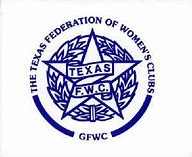Texas Federation of Women's Clubs facts for kids
 |
|
| Abbreviation | TFWC |
|---|---|
| Predecessor | Texas Federation of Literary Clubs |
| Founded | 1897 |
| Founded at | Waco, Texas |
| Type | Non-governmental organization |
| Purpose | volunteerism |
| Affiliations | General Federation of Women's Clubs |
| Website | https://www.gfwctexas.org/ |
The Texas Federation of Women's Clubs (TFWC) is a non-profit group for women in Texas. It was started in 1897. The main goal of the TFWC is to bring together women's clubs and their members across Texas. They work on many important topics. These include education, protecting the environment, improving home and community life, supporting the arts, and preserving Texas history. Did you know that TFWC members helped create about 70% of the public libraries in Texas? That's a huge impact!
Contents
How the TFWC Began
The TFWC started from many local women's clubs all over Texas. These clubs often met for "self-culture and intellectual development." This means they wanted to learn and grow their minds. Over time, members realized that clubs could do even more if they worked together. They thought sharing ideas and communicating across the state would be very helpful.
In 1894, a special meeting called the Woman's Congress happened at the Texas State Fair in Dallas. This event brought together many women's club members from different parts of Texas. They shared ideas and made connections. This helped shape the future of the TFWC.
As early as 1895, a group called the Wednesday Club of Fort Worth suggested creating a federation of women's clubs. But it was Mrs. Edward Rotan (Kate Sturm McCall Rotan) from Waco who made it happen. She sent letters inviting different clubs to send representatives. Their goal was to create the TFWC.
First Steps and New Name
The TFWC first organized in 1897. It was called the Texas Federation of Literary Clubs. Mrs. Rotan was chosen as the first president. Olga Bernstein Kohlberg became the first vice-president.
Twenty-one clubs were part of the TFWC when it first started. These clubs came from cities like Austin, Dallas, Fort Worth, Houston, and Waco. To join, a club needed to be recommended by two other clubs already in the TFWC. In 1899, the group joined the General Federation of Women's Clubs. At this time, they changed their name to the Texas Federation of Women's Clubs. By 1901, the TFWC had grown to include 132 clubs.
Making a Difference in Texas
The TFWC has worked on many important projects over the years.
Helping Libraries Grow
In 1898, the TFWC decided to help create public libraries across Texas. From 1901 to 1903, Anna Pennybacker was president. During her time, she helped start a "traveling library and art collection." She also raised $3,500 for scholarships for women at the University of Texas.
Later, the TFWC played a big part in creating the Texas State Library and Archives Commission. Along with the Texas Library Association and George Garrison from the University of Texas, the TFWC helped pass a bill in 1909 to create the Texas State Library. The TFWC also worked hard to set up "traveling libraries" throughout Texas. These libraries brought books to many communities. The TFWC managed these libraries until 1916, when the Texas State Library took over.
Preserving History
The TFWC has also been involved in saving important historical places. In 1904, they helped raise money to buy the Alamo Mission and the land around it. This helped protect a very important part of Texas history.
Supporting Education and Arts
By 1916, the TFWC had 450 clubs and 16,000 members. The group encouraged women to run for local school boards. This helped women have a say in their children's education. In 1923, the TFWC started publishing its own newspaper, the Texas Federation News.
In the 1920s, the TFWC also organized traveling art exhibits. Mrs. H.B. Fall helped create "cottage art centers" across Texas through the TFWC. These centers made art more accessible to people in different communities.
Growth and New Causes
In 1932, the first stone was laid for the Texas Federation of Women's Clubs Headquarters in Austin. By the late 1930s, the TFWC had grown even more. It included 1,200 clubs and about 60,000 members.
The TFWC also supported women's health and well-being. In 1936, with the help of Katie Ripley of Dallas, the TFWC passed a resolution. This resolution recommended that health services for women be provided by state and local public clinics.
In 1948, the Texas Federation News changed its name to the Texas Clubwoman. This magazine is still published today.
Over time, the number of clubs and members decreased. In 1985, there were 13,000 women and 500 clubs. By 1992, there were 384 clubs. However, the TFWC continues its work to this day.
Notable Members
- Olga Bernstein Kohlberg: She was the first vice president of the TFWC.
- Anna Pennybacker: She served as president from 1901 to 1903.
- Mary Shapard: She was nominated for a Nobel Peace Prize.
- Cornelia Branch Stone (1840–1925): She was the first vice president of TFWC. She also led other important groups like the United Daughters of the Confederacy and the Texas Woman's Press Association.
- Adella Turner: She was president from 1904 to 1906.
See also

